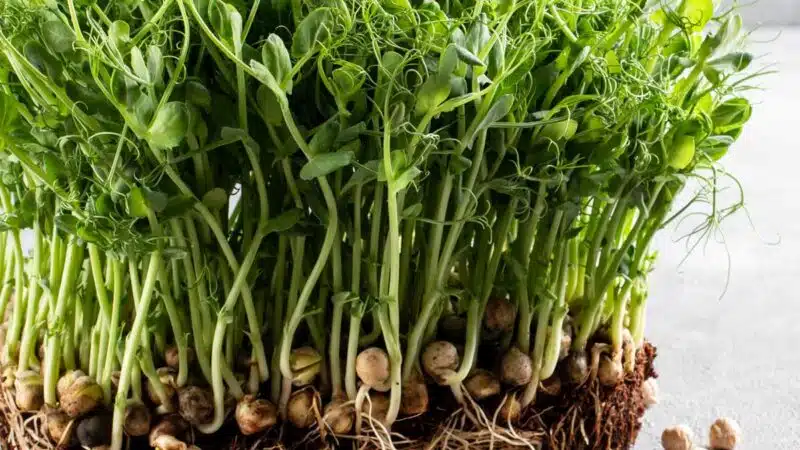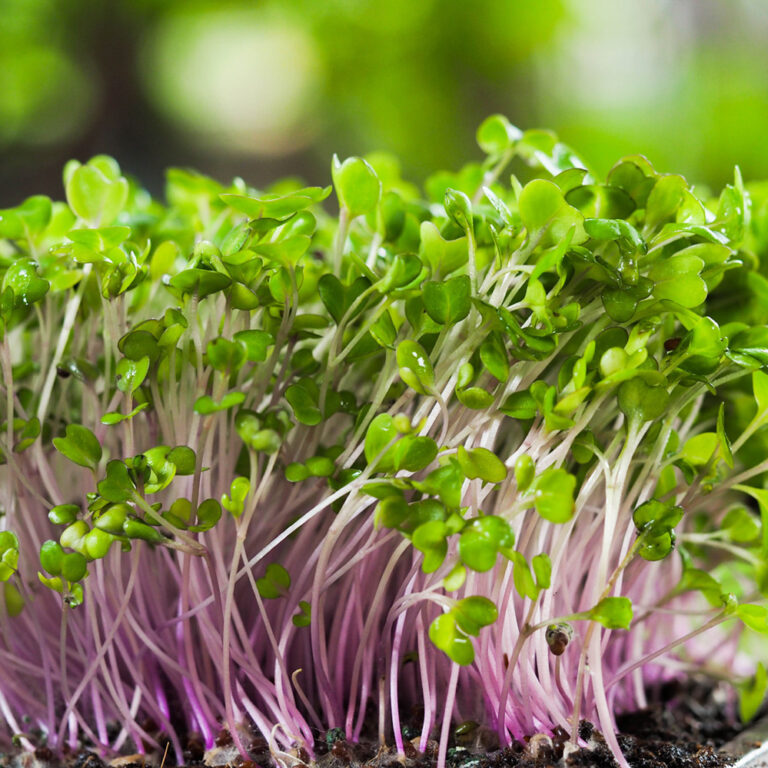How to grow microgreens
Microgreen Growing Guide: This guide shows you how to start your own small microgreen garden at home, guiding you through the most popular organic seeds that you can eat all year round.
Learn how to grow microgreens all year round so you always have fresh, nutritious vegetables. We guide you from seed selection to harvest, so you can easily succeed in growing your own microgreens and make it as easy as child's play.
What is microgreen
Microgreen which is also known as microgreens in Danish, is next in terms of edible plants. Microgreens are plants and herbs that can be eaten as soon as the cotyledons have developed, even if the plants are not yet fully grown and fully developed. Depending on the type, mini greens can be harvested approximately 1-2 weeks after germination. The harvest includes both the germ stem and leaves, but not the germ which is left in the growing medium/soil. It is almost the entire plant that is edible!
The mini plants have a delicious aromatic taste, and their nutritional content is much more concentrated than in the adult plants. These mini plants come in many different colors and textures. Microgreens are considered to be baby plants, they fall between being a sprout and baby green/mini green. However, this does not mean that Microgreens are the same as sprouts, which do not have leaves.
Unlike microgreens, sprouts have a shorter growth cycle, typically between 2-7 days, whereas microgreens can normally be harvested after about 7-14 days after germination, when the plant's true cotyledons have emerged. After about 7-14 days, your plants have achieved the same flavour as the finished vegetable, such as broccoli or peas, making microgreens much more suitable for cooking than sprouts, plus, as mentioned, they are super healthy.
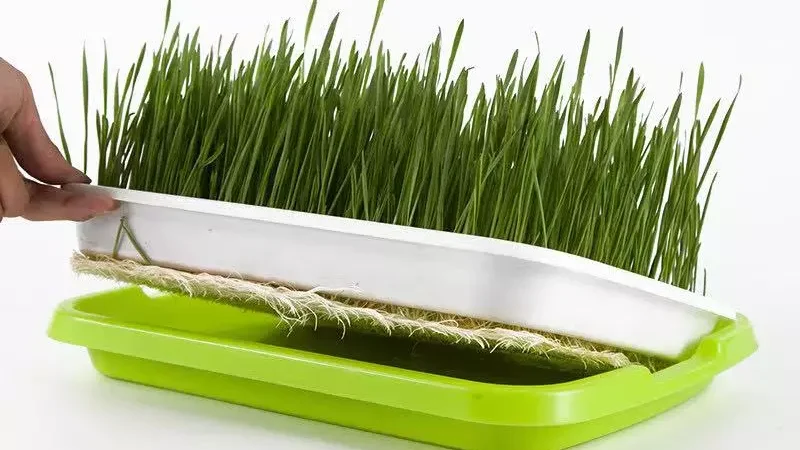
Everything you need to know about microgreen trays
In order to get the optimal use of your production of microgreens, you can advantageously use microgreen trays. Micro green trays have the advantage that they are designed to provide the optimal growth conditions for your micro plants, including the perfect drainage of the water, so that the small soft roots do not rot or mold grows in your micro greens. It is therefore very advantageous to use a microgreen tray, but if you want to be a little creative you can also try to make your own tray, perhaps from a milk carton?
Here on the webshop, the trays are available in many different versions, the low trays of 25 mm are suitable for small plants, e.g. broccoli or radishes, whereas larger plants such as pea sprouts should have high trays of 35 mm, which better support the tall thin plants. See the selection here
The black microgreen trays are made of thick solid recycled plastic, and are therefore of high quality. If you choose to invest in a microgreen tray, you need both one top and one bottom. The top part is what we call the "microgreen tray", this is where you put the growing medium and where you will sow your seeds. The bottom is called the "sub-irrigation tray", this part is also very important, as this is where the water you water with will drain away so that it is accessible to the roots of the microgreen without the risk of the water drowning your microgreen.
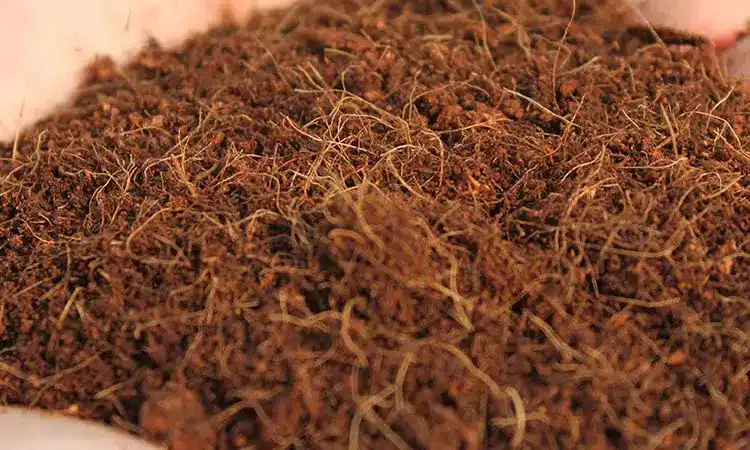
Guide to green food and fertiliser
When growing microgreens, it is best if the roots of the plant sprouts have something that can hold the plant firmly while it grows. There are many good options here, e.g Coco's fiber, hemp mats, fibre mats, sphagnum, rockwool and special netted planters. But many also choose to experiment with paper towels, cotton wool, paper and garden soil etc.
However, we strongly advise against using garden soil as it contains far too many bacteria and diseases, which can end up contaminating and destroying the delicate microgreen plants and making it inedible. But all the other options we mentioned can all lead to really good results. FHowever, iber mats and sphagnum are not particularly environmentally friendly, so we recommend using one of the other three options. Rockwool has the problem that it can be difficult to buy in small packages, therefore the best choice is typically hemp mats or coconut fiber.
Unfortunately, it has not been possible for us to find a supplier that can deliver hemp mats, which, according to the cultivation trials we have carried out ourselves, can deliver as good results as coconut fiber. We therefore only sell coconut fiber mulch here at plantelys.dk. You can read more about all the great things about coconut flour here
When you are going to grow microgreens in coconut soil, you must start by preparing the soil, this takes about an hour. Coconut soil has an extremely high absorption capacity. The coconut mulch you will receive is what is called a compressed "brick". The brick is therefore just coconut fibers that have been pressed together, what must happen now is that it must be de-compressed.
This is done by mixing the coconut mulch with water in a ratio of approximately 20% coconut and 80% water. Stir the mixture regularly while letting the coconut soak up the water for half an hour to a full hour. Coconut soil is completely sterile, so to ensure that there are enough nutrients for your microgreens, we recommend that you add a little of the Danish produced fertilizer A+B from Big Plant Science for your coconut soil. You are now ready to sow your microgreen seeds!
What seeds can I use to grow microgreens
Before you can start growing your own microgreens, it is necessary to acquire some seeds. Here it is important to choose organic seeds. The Plant seeds that you can buy in supermarkets and DIY stores are usually treated. Among other things, they are treated with a fungicide that is toxic to humans. So making microgreens with the wrong seeds can be harmful to your health.
| Frog | Taste |
|---|---|
| Radish | Sharp |
| Broccoli | Nourishing |
| Alfalfa | Mild |
| Sunflower | Nutty |
| Pea shoots | Sweet |
| Red clover | Crunchy |
| Wheat grass | Green |
| Cress | Peppery |
| Amaranth | Colourful |
| Fenugreek | Spicy |
How to grow microgreens at home a step by step guide to growing microgreens
- The hill - A heavy-duty plastic germination and submersion tray is almost indispensable, this seed tray is designed so that you can water from below and thus avoid knocking down the fine new micro-vegetables and avoid them being stained by lime from the water. A growing medium is placed in the seed tray, there are different types, e.g. hemp mats and coconut fiber. In addition, you need a lid, as the seeds germinate in the dark.
- Frog - Once the tray and growing medium have been placed and moistened, seeds are added. We recommend that you only use organic seeds for your microgreens, conventional seeds are coated with fungal toxins and because microgreens only grow for a short time, the toxins don't have time to leach away before you harvest your microgreens.
- IMPORTANT: When your seeds are ready growth medium In the germination tray they should be covered, preferably with a weight on top, the seed germinates in the dark and when it is pressed lightly against the growing medium, it will more easily take hold and attach its tiny roots - once the seeds have germinated, remove the lid and let the seedlings get light.
- Light - With a full-spectrum grow light above your plants, you can grow microgreens anywhere from basement to attic, all year round. A dark room can be an advantage because you can completely control the environment, for example, you can avoid water evaporating faster than you can water them if they get full sun. In a windowsill, you risk too much heat, which causes the water to evaporate and the little sprouts will quickly die if you don't take care not to let them dry out. A grow lights lamp over a kitchen table or elsewhere is also a really good solution and is probably also what most people do when growing at home, it is so wonderful for both children and adults to follow how quickly they change from seeds to the most wonderful micro-vegetables.
- Gromedie - Cultivation with the graminoid Coco coir is an easy and sustainable way to grow microgreens. Coco coir helps maintain an ideal moisture balance that ensures good drainage. Spread the seeds evenly over the moist coco coir and water gently.
Your microgreens are rich in nutrients and flavour and are ready to harvest within 2-3 weeks.
You can read more inside Microgreen growing - beginner's guide
Growing guide for microgreens: broccoli
Broccoli grown as a microgreen is not exactly like regular broccoli, but of course there are many similarities. Regular broccoli is very rich in vitamins, but micro green broccoli is even more rich in vitamins! It has a very high content of both A, B, C, E and K vitamins.
Broccoli as a microgreen has a lovely taste of broccoli. The taste is though relatively mild and therefore not too strong for you to enjoy it.
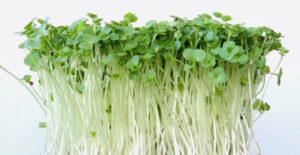
Growing Instructions for Microgreen Broccoli:
- Prepare your growing medium | chapter on growth media
- Place your growing medium in the microgreen bark or in your chosen growing container
- Then yours delicious organic broccoli seeds so they laying close, but at the same time make sure they are evenly distributed. (The seeds must go down the hill, but on top the growing medium, it is important that you do not bury the seeds.)
- For the first 2 days after sowing, the seeds should be kept in the dark, either by placing the tray in a dark room, or by placing something over the tray.
- It is difficult to say exactly how often you should water the seeds, as it can vary greatly depending on the tray, the medium and the indoor climate. You should therefore always be aware yourself that there is enough water so that they do not dry out.
- The broccoli sprouts after just 2-3 days, and it can be harvested as a sprout after 5 days. However, we recommend postponing the harvest until the broccoli is ready as microgreens, this takes approximately 12-14 days. As a microgreen, there is both a stronger taste and a higher nutritional content of healthy vitamins.
- Prepare as a delicious microgreen dish! Bon appetit!
Growing instructions for microgreens: Radish
Here at plantelys we sell many different varieties of radish seeds, both the classic green radishes, but also some of the beautiful purple and pink species. But you don't need to worry about the differences, because they are all organic, delicious and easy to grow! Radishes grown as microgreens have a lovely and intense taste of radish, perfect for the smørrebrød or cheese board!
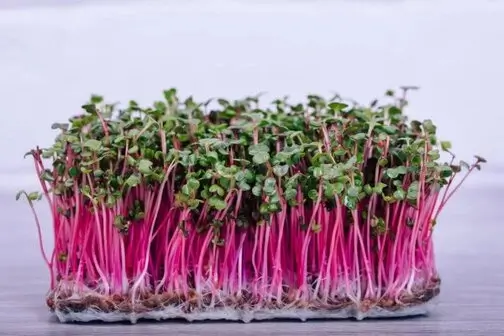
Growing instructions for microgreen radishes:
- Before cultivation, the organic radish seeds must be soaked in clean tap water for approximately 8 to 12 hours. Radishes are a very moisture-demanding plant, and this therefore ensures that there is enough moisture.
- Prepare your growth medium as usual, but with extra water | chapter on growth media
- Place your growing medium in the microgreen bark or in your chosen growing container
- Then yours delicious organic radish seeds so they laying close, but at the same time make sure they are evenly distributed. (The seeds must go down the hill, but on top the growing medium, it is important that you do not bury the seeds.)
- For the first 36-48 hours after sowing, the seeds should be stored in the dark and with very high humidity. The easiest way to ensure high humidity is to lay a piece of non-transparent plastic or silver paper over your plant tray, so that it can keep the moist air in and the light out.
- It is difficult to say exactly how often you should water the seeds, as it can vary greatly depending on the tray, the medium and the indoor climate. But as I said, radishes require a lot of water/moisture, so you should therefore always be aware that there is plenty of water, but it is important that there is not so much water that it touches the seeds.
- The radishes will start to sprout after only about 2 days, now it is important that they get lots of light. After approximately 6-8 days, the sprouts can be harvested as radish sprouts. But it must be said that you will get a bigger and better harvest if you wait another 4-5 days, because then the radishes are ready to be harvested as microgreens. Microgreens have both a stronger taste and more healthy vitamins.
- Use your microgreens in a delicious dish! Bon appetit!
Growing instructions for microgreens: Cress
Watercress is in many ways the original microgreen. In any case, it is a microgreen that many Danes have tried to grow before, even if they never even thought about it being a microgreen. But there are many good reasons why watercress is so popular, the first of course is the lovely peppery taste, but it is also because it is one of the easiest plants to grow as a microgreen.
A third bonus, which is not as widely known, is the enormous health potential of watercress. Watercress contains vitamins A, B, C and E, and it even has a very high protein content, almost 20-25 percent, so it is a bit of a bodybuilder super food.

Growing instructions for micro green cress:
- It is not necessary to soak watercress before sowing
- Prepare your growing medium as usual, but with a little extra water | chapter on growth media
- Place your growing medium in the microgreen bark or in your chosen growing container
- Then yours delicious organic cress seeds so they laying close, but at the same time make sure they are evenly distributed. (The seeds must go down the hill, but on top the growing medium, it is important that you do not bury the seeds.)
- Cress benefits from light throughout its life cycle, but high humidity is still important. We therefore recommend that you use one mini greenhouse for your watercress, this helps to keep the moisture in and create high humidity, but of course you can also easily succeed in growing your watercress without it.
- Water frequently, but still make sure you don't water so much that the water table reaches up and hits the seeds, otherwise you risk drowning the watercress.
- The watercress will quickly begin to sprout. Already after just 6-7 days you can start harvesting the watercress sprouts. But you, you can easily leave your watercress and then harvest a little bit at a time for a longer distance.
- Your watercress is now absolutely perfect on top of the scrambled eggs! Bon appetit!
Growing instructions for microgreens: Sunflower seeds
We all know about you beautiful yellow sunflower flowers, unfortunately no beautiful sunflower flower comes when we grow it as a microgreen, but there is a lot of other delicious things about them! Sunflower seeds grown via our growing guide for microgreens will turn into a small fresh sprout, but still a bit thick and robust. As with all other microgreens, the whole plant can be eaten, i.e. both leaves and stem. The stem from sunflower microgreens has a lovely sunflower seed/nut flavour.
Most microgreens are full of vitamins and really healthy for you! This also applies to sunflower microgreens, because it is both rich in A, B, C and E vitamins, and depending on fertilizer and light conditions, it has a protein content of between 20 and 25%.
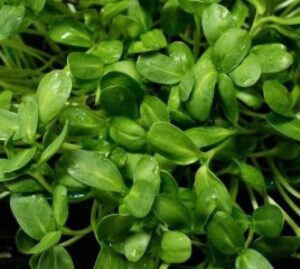
Growing instructions for microgreen sunflower:
- As with radish seed shell the organic sunflower seeds are laid soak in clean tap water for approximately 8 to 12 hours inden cultivation. sunflower is a very moisture-demanding plant, and this therefore ensures that there is enough moisture.
- Prepare your growing medium as usual, ensure plenty of water | chapter on growth media
- Place your growing medium in the microgreen bark or in your chosen growing container
- Then yours delicious organic sunflower seeds so they laying close, but at the same time make sure they are evenly distributed. (The seeds must go down the hill, but on top the growing medium, it is important that you do not bury the seeds.)
- For the first 48 hours after sowing, the seeds should have a lot of moisture and as little light as possible. This can easily be achieved by laying a piece of non-transparent plastic or silver paper over your plant tray so that it can keep the moist air in and the light out.
- It is important that you water the sunflower frequently, we usually water our sunflower microgreen approximately every other day. But avoid too much water, as you risk drowning the sunflower sprouts.
- After approximately 14 days, your delicious home-grown sunflower sprouts will be ready to be harvested as microgreens.
- Your sunflower microgreens are now completely ready to become an important ingredient in a lovely salad! Bon appetit
Growing instructions for microgreens: Beetroot
Beetroot is one of the most beautiful types of microgreens on the market. But they are not only beautiful for your eyes, they are also very beautiful for your mouth! In addition to the strong red color, roe tastes goodthe microgreens are absolutely delicious.
Beetroot microgreens, which are grown via our growing instructions for microgreens, have a very strong beetroot taste, which is far more concentrated than in regular beetroot. Home-grown beetroot microgreens are therefore a fantastic substitute for the normal beetroot in your liver pâté. It is not only more strongly tasting, it is also even better for your health than conventional beetroot!
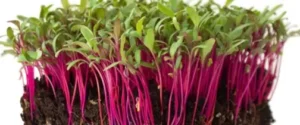
Growing instructions for microgreen beetroot:
- As with sunflower shell the organic beetroot seeds are laid soak in clean tap water. Beetroot, however, has an even higher water requirement, and must therefore lie for about twice as long, i.e. approximately 12 to 24 hours.
- Prepare your growing medium as usual, ensure plenty of water | chapter on growth media
- Place your growing medium in the microgreen bark or in your chosen growing container
- Then yours delicious organic beetroot seeds so they laying close, but at the same time make sure they are evenly distributed. (The seeds must go down the hill, but on top the growing medium, it is important that you do not bury the seeds.)
- Beetroot can tolerate light well throughout its life cycle, the most important thing is to maintain a high humidity. We therefore recommend that you use a mini greenhouse for your beetroot sprouts. The transparent lid in the greenhouse will allow the sun to enter and cause water to evaporate, but at the same time the greenhouse will retain the air/water and therefore increase the humidity.
- Beetroot is probably the most water-demanding microgreen, and therefore you can hardly water it too often. You should therefore just give it water as often as possible, but make sure that the water does not run up and hit the seeds, as this can cause complications.
- After 4-5 days, your delicious home-grown beetroot seeds will start to sprout, but they are not ready to eat yet. You must therefore let them grow for approximately 10 more days, i.e. 15 days in total, before it is completely ready to be harvested.
- Your home-grown organic beetroot microgreens are now ready to pimp up any smørrebrød's food to a whole new level! Bon appetit!
Growing instructions for microgreens: Pea seeds
Peas grown in the ground are not just peas. They also work as a soil improver in that they add extra nitrogen (nitrogen). The extra nitrogen is very good as fertilizer for new plants that can be planted in the ground. However, this also means that you cannot grow peas in the same bed several years in a row, as they will then put too much nitrogen in the soil, which will result in excess fertilizer which is therefore toxic to plants. It is therefore really smart to grow peas as microgreens. As a microgreen, you grow your peas indoors without any soil! You can therefore grow peas again and again and again without any problems.
Another benefit of growing peas as a microgreen is the fantastic taste. Pea sprout microgreens taste like, you can probably guess, peas! They therefore have a fresh and lovely taste of peas. The extra easy thing about them is that you don't have to peel the pea pods, because there aren't any at all. As a microgreen, you can eat the entire visible part of the plant, i.e. both the stems and the leaves, and both things have an absolutely delicious and fresh, sweet pea taste.
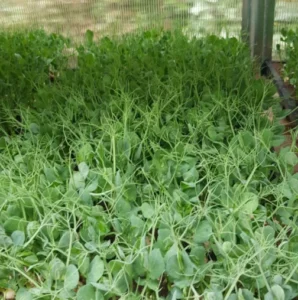
Growing instructions for microgreen peas:
- We recommend that you soak your pea seeds in water before sowing. We usually say that peas, like many other microgreens, should be soaked for approximately 8-12 hours. Or until you can see that the pea seeds have absorbed enough water to be completely round.
- Prepare your growing medium as usual, make sure there is plenty of water, it must be a bit messy | chapter on growth media
- Place your growing medium in the microgreen bark or in your chosen growing container
- Then yours delicious organic pea seeds so they laying close, but at the same time make sure they are evenly distributed. (The seeds must go down the hill, but on top the growing medium, it is important that you do not bury the seeds.)
- During the first 48 hours, i.e. the early part of the germination process, the pea seeds do best if they are in an environment with high humidity and a low light level. There are many ways to do this, but some of the best are by placing a damp tea towel over the microgreen bark, a piece of non-transparent plastic or silver paper will also work.
- Pea sprouts also require a lot of water, so you can easily water frequently as long as the water does not come into direct contact with the seeds, as this can drown them.
- After about two weeks, your delicious pea sprouts will be ready to be harvested. Peas, however, are not quite like all the other microgreens, as they can be harvested several times. If, after the two weeks, you only harvest the upper parts of the stems, so that there are still a few centimeters left, and you continue to water them, you can harvest again after another week. This can typically be done 2-3 times.
- Your home-grown pea-stalk microgreens are now ready, and only your imagination sets the limits to what dish they can become! Bon appetit!
Growing instructions for microgreens: Red cabbage seeds
Red cabbage is one of the most important cabbage varieties in classic Danish gastronomy. It is both because of its beautiful and eye-catching color but also because of the delicious taste, and you can also use it in science as a cheap ph indicator. There is really no plant that deserves its place in the Danish kitchen more than red cabbage.
A recurring theme in this growing guide for microgreens is that the microgreens are slightly different from their full-grown counterparts, this also applies to red cabbage. Microgreen red cabbage is in many ways not the same as red cabbage, and it is not at all, not at all the same as the red cabbage you can find in glass in the supermarkets. It is even healthier! Because red cabbage as a microgreen actually has almost 6 times as much vitamin C and 40 times more vitamin E than ordinary fresh red cabbage, as well as a high overall nutritional and mineral content, it also contains an abundance of vitamins A, B1, B2 and B3. It is therefore one of the healthiest microgreen varieties that you can grow!
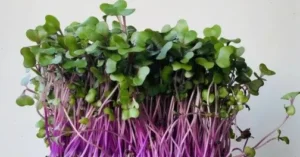
Growing instructions for micro green red cabbage:
- Contrary to what you might be told elsewhere, it is not actually necessary to soak red cabbage seeds in water before sowing.
- Prepare your growing medium as usual | chapter on growth media
- Place your growing medium in the microgreen bark or in your chosen growing container
- Then yours delicious organic pea seeds so they laying close, but at the same time make sure they are evenly distributed. (The seeds must go down the hill, but on top the growing medium, it is important that you do not bury the seeds.)
- For the first 48 hours, after sowing, it is best to keep the plants dark and moist, this helps to start root production. You can keep the microgreen bark moist by laying either a wet tea towel over the microgreen bark or a piece of non-transparent plastic. Silver paper can also be used.
- After the 48 hours, the red cabbage must have as much light as possible, either from the sun or from a grow lights. The light can make the water evaporate faster, so you should water your red cabbage daily, but make sure not to drown the plant.
- After approximately 12 to 14 days, your micro green red cabbage will be ready to be harvested. But if you are not quite so patient, you can also eat them as sprouts after about 3-6 days.
- Your home-grown red cabbage microgreens are now ready to be part of a nice salad or smoothie! Bon appetit!
If you need help or want to know more, you are more than welcome to contact our team of experts here
FAQ - Frequently asked questions
To plant peas as microgreens, you need to:
- Choose pea seeds suitable for microgreens.
- Make sure the seeds are clean and of good quality.
- Soak the seeds in water for 8-12 hours to speed up germination.
- Spread the soaked seeds evenly over a moist growing mat or soil in a tray.
- Lightly cover the seeds with additional soil or another tray to create darkness and moisture.
- Keep the seeds moist and at room temperature.
- Remove the cover when the seeds start to germinate and ensure good lighting.
Microgreens are grown by sowing seeds densely in trays of soil or a growing mat and then growing them indoors under controlled conditions (light, temperature and humidity) until they are ready for harvest, typically in 1-3 weeks, depending on the species.
Many different seeds can be used for microgreens, including:
- Peas
- Cress
- Radish
- Broccoli
- Mustard
- Arugula
- Spinach
Peas as a microgreen typically take between 7 and 14 days from sowing to harvest. The time can vary depending on growing conditions.
To grow cress as a microgreen:
- Sow cress seeds evenly on a damp growing mat or in a tray of soil.
- The seeds do not need to be covered with soil as cress requires light to germinate.
- Keep the growing medium moist, but avoid overwatering.
- Place the tray in an area with good lighting.
- Cress is ready to harvest within 5-7 days.
The cotyledons are the first leaves that develop at seed germination and play a major role in early growth. The cotyledons act as nutrients for the actual leaves to come
The seedling is the plant that emerges after germination of the seed. It is the early growth phase that includes cotyledons, a radicle and a rhizome but the plant has not yet developed its actual leaves and root system
